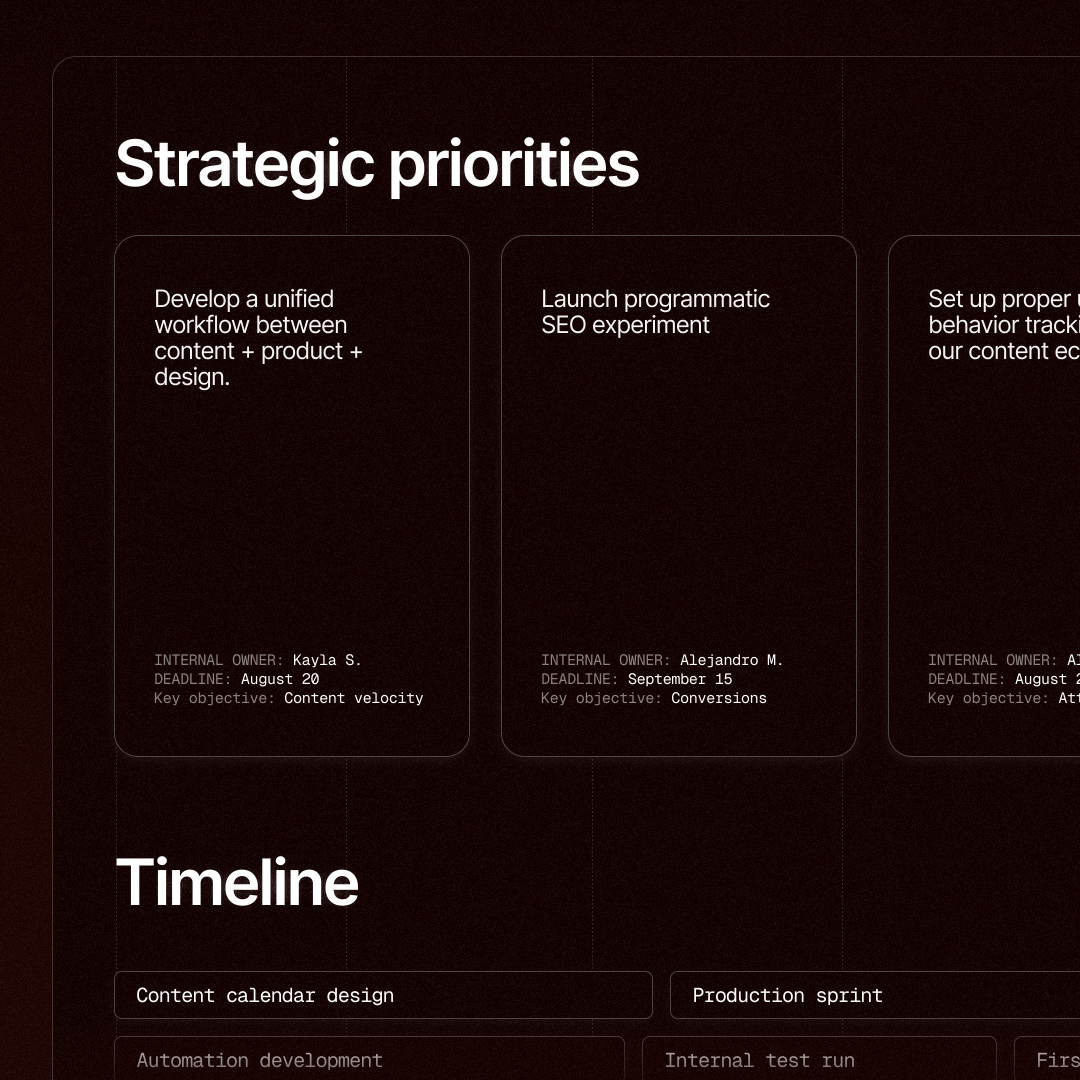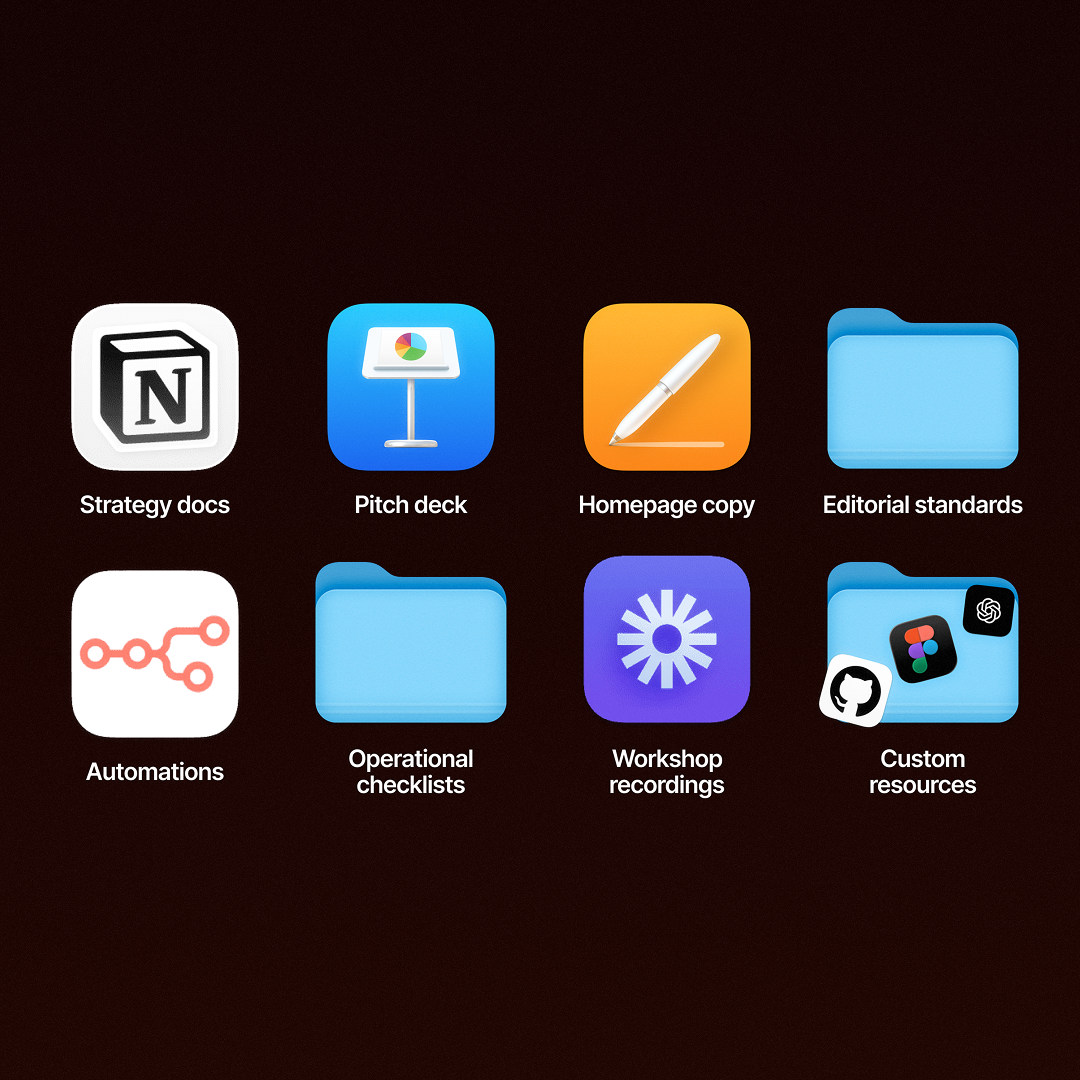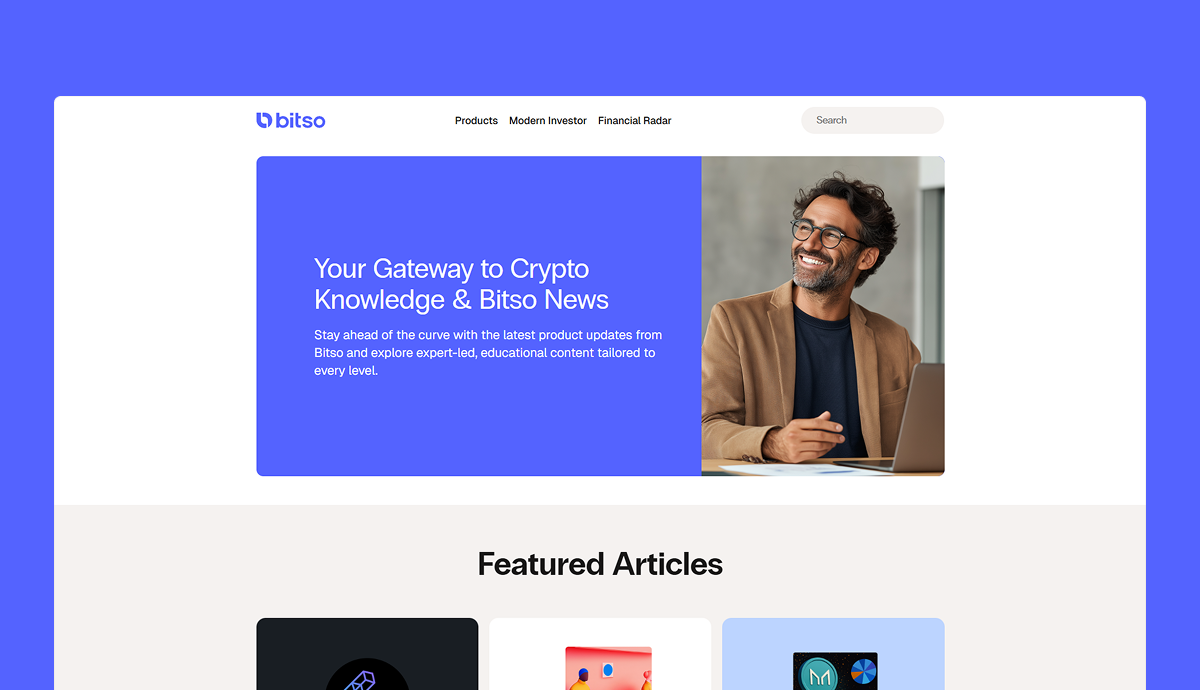
The strategy sprint
that actually ships
You know something's broken. Your positioning isn't landing. Your content isn't converting. But another 6-month agency engagement with junior execution and bloated retainers? Not happening. The Program is different: 4 weeks. One strategic roadblock. Fixed outcomes.

Your positioning is fuzzy and your message is inconsistent. Buyers can’t quickly tell what you do or why it’s different. This slows down deals and pushes buyers to compare on price and features instead of value. Your content? It keeps the marketing team busy, but you can't tie it to any closed deals - it's just there, on Google's third page.
Imagine if you could solve these issues in just a couple of weeks, and go back to a growth trajectory.
Two tracks, same promise: Clarity & growth
Brand sprint
The problem
Your positioning is muddled. Prospects don't get what you do or why you're different. We clarify your strategic narrative and messaging architecture.
The misconception
"Following industry trends, redesigning our landing page for the 17th time and buying yet another prospecting tool."
SEO sprint
The problem
You're publishing into the void. No strategy, inconsistent execution, zero pipeline impact. We build your content engine from the ground up.
The misconception
"We need more content - let's automatically produce 5,000-word guides and the leads will come."
We fill knowledge gaps
You've got resources and you know everything there is to know - from user research methods to SEO best practices. But your strategy isn't working because you're missing out on something. It may be the true conditions of your competitive landscape, or some invisible user needs. We help you find and fill those knowledge gaps.


We've got a plan
Once we understand your context, we design a plan to bring you closer to your goals. We partner with your team to steer the ship in the right direction, while adopting better processes and higher standards. We build the blueprint: positioning framework, messaging hierarchy, or content strategy and operational playbook. No theory. Just what you can execute tomorrow.
We equip & train your team
We don't hand you a deck and disappear. We implement alongside you - first drafts, initial campaigns, internal rollout. You finish with momentum, not homework.

World-class marketing consulting at a flat fee
No retainers. No handoffs. We diagnose, design, and ship with you.
Founders & marketers from all around the
world trust us to solve their most pressing challenges
"Our blog revamp collaboration has been invaluable. The whole team has actively taught us how to manage tasks we previously outsourced entirely. Their willingness to share knowledge and empower our team has been a game-changer, genuinely scaling our internal capabilities. Although the project is ongoing, we're already in a great place, and we're excited to see the final results."
"They understood our brand as a whole and worked hard to help us reach our goals."
"You were highly recommended by a friend, and from the moment I started to work with you guys, you were the team I was looking for. I did not have to worry about anything, you guys took care of everything. Easy, fast & very communicative. Everything was clearly outlined and me & the team knew exactly what was going on. Simply love working with you guys."
"This is great! This is exactly what I was solving for, yet didn’t know how to even articulate it."
"I was very doubtful that someone could produce high-quality content about what we do. But not only did you meet my expectations, I'd say that you even surpassed them. I love the fact that you're as committed to lead generation as I am. Other vendors usually focus on their output, but not on the result that the client wants, which is increasing sales. You're different in that sense and that's something I really like."
"To work with Post is to rest assured that the work will exceed my expectations. They go the extra mile with every deliverable, and it shows. Aside from the content quality, they’re fast and solution-oriented. I recommend them 100%!"
"Thanks to Postdigitalist we’ve been able to transmit knowledge and ideas about a new industry, such as Crypto, in an agile and casual way. They’ve adopted our company’s goals as their own and developed a communication strategy with our business goals in mind. I highly recommend their talent and expertise."
"The outcome was super positive with end users and investors praising the UX/UI of our web3 app. Their workflow was excellent. They demonstrated dedication, accountability, quality, and approachability."
"The Postdigitalist Team is hands down one of the most professional, organized, and easy to work with 3rd party companies that I have had the pleasure of collaborating with!"
"Great culture fit, good value for cost, very responsive."
“You challenged us with new ideas and proposals that benefited both the brand and the business.”
Problems we solve
Unclear positioning
Positioning is fuzzy; prospects can’t clearly explain what the company does or why it matters.
Disconnected messaging
Mixed messages across channels; sales and marketing tell different stories, leading to confusion and longer sales cycles.
Tons of content, no leads
Content is inconsistent, unstrategic, and disconnected from pipeline outcomes.
Dark data
Nobody tracks which content is actually converting - and if that data exists, it's not being properly implemented.
Post-pivot uncertainty
You listened to your customers and pivoted your company to serve them better. But that left you with outdated messaging and irrelevant content.
Funding round coming
It's time to raise capital - and while you have the metrics to prove product-market fit (or at least commercial potential), you don't know how to articulate them into a story that sells.
Outdated SEO playbook
Your content would have worked wonders in 2015. But nowadays, it barely reaches the second page of Google. You're still paying thousands for blog posts that bring no conversions.
Do these challenges resonate with your company?
It's time to get back on the path to growth. We can help 👇
Book a consulting callAverage results*
*within 3 months after the sprint
Let's build a Marketing OS that brings revenue,
not headaches
Frequently asked questions
Ask away!How is this different from a typical agency engagement?
Traditional agencies put junior staff on your account, charge $10K-50K+, and drag projects across months. We're senior consultants only, $x,xxx flat, done in 4 weeks with managed execution.
What happens after the 4 weeks?
You own everything: frameworks, templates, initial content, and the operational playbook. You're equipped to continue independently. If you need ongoing support, we can discuss that separately - but it's not required.
What's included in "managed execution"?
Week 4 isn't about handing you homework. We create first drafts, launch initial campaigns, brief your team, and ensure everything is implemented and working - not just theoretical.
How much of my time does this require?
Expect 3-5 hours per week: interviews in Week 1, feedback sessions in Weeks 2-3, and implementation collaboration in Week 4. We do the heavy lifting, but need your strategic input.
What if we need both Brand AND Content tracks?
They're separate engagements, but we can run them sequentially (Brand first, then Content) or discuss a custom scope. Most companies start with Brand since positioning informs content strategy.
Who exactly will I be working with?
Our co-founders: Aaron Marco Arias & Facundo Vázquez, two senior marketing consultants with years of international experience. No handoffs to junior strategists or account managers. We’ll meet on the sales call - so you'll know exactly who you're getting before you commit.
Do you offer payment plans?
50% of the total fee is due upfront and the remaining 50% is due at the start of the fourth week. This keeps the engagement focused and ensures both parties are fully committed to the sprint timeline.
How do I know if I'm ready for this?
You're ready if you can clearly articulate what's broken but not how to fix it, can dedicate time during the 4 weeks, and are prepared to implement (not just collect another strategy document).
What happens if we're not a good fit?
We'll know in the 30-minute diagnostic call. If we don't think we can deliver meaningful results in 4 weeks, we'll tell you upfront and potentially point you toward better alternatives. No hard feelings.







